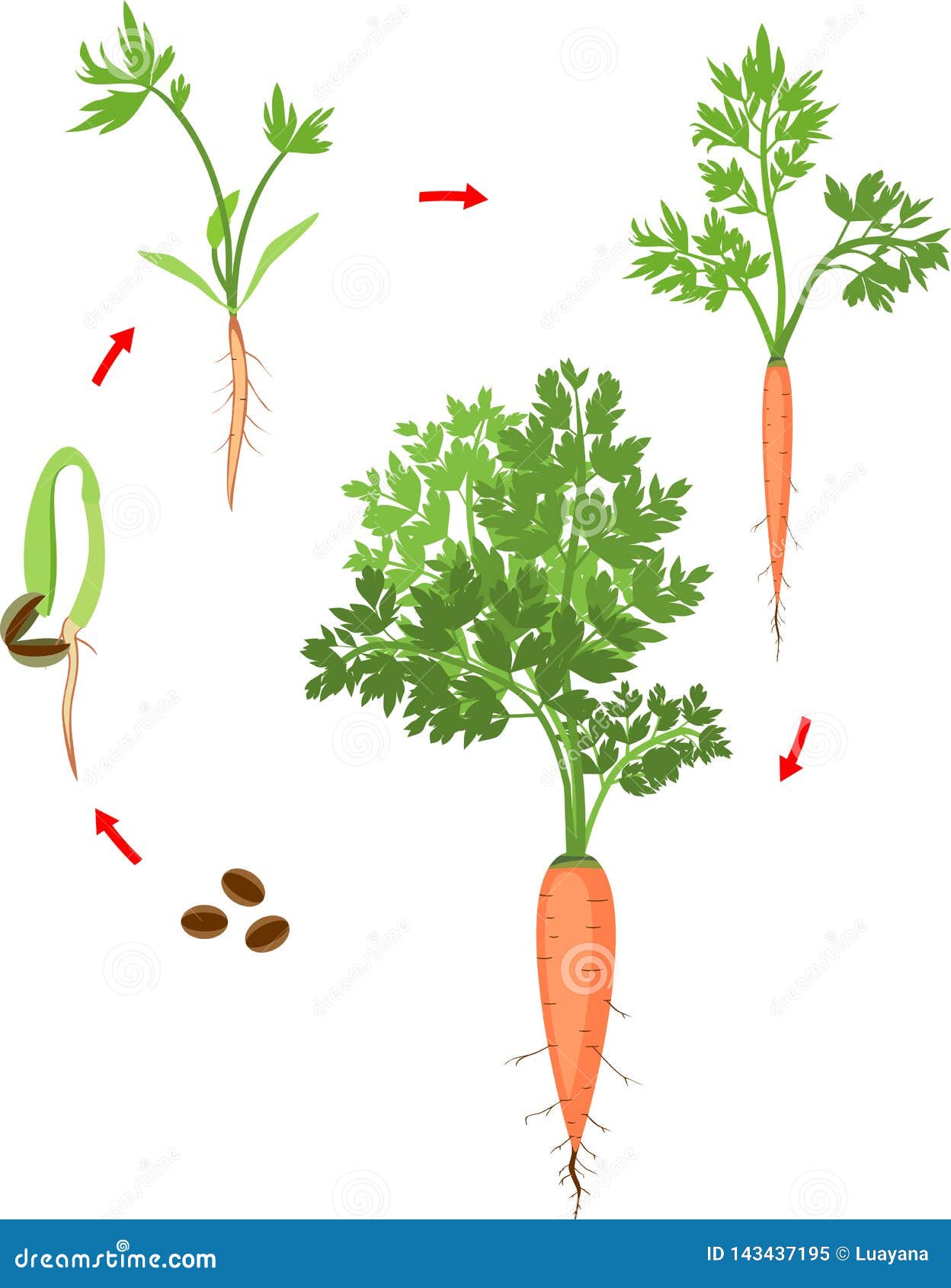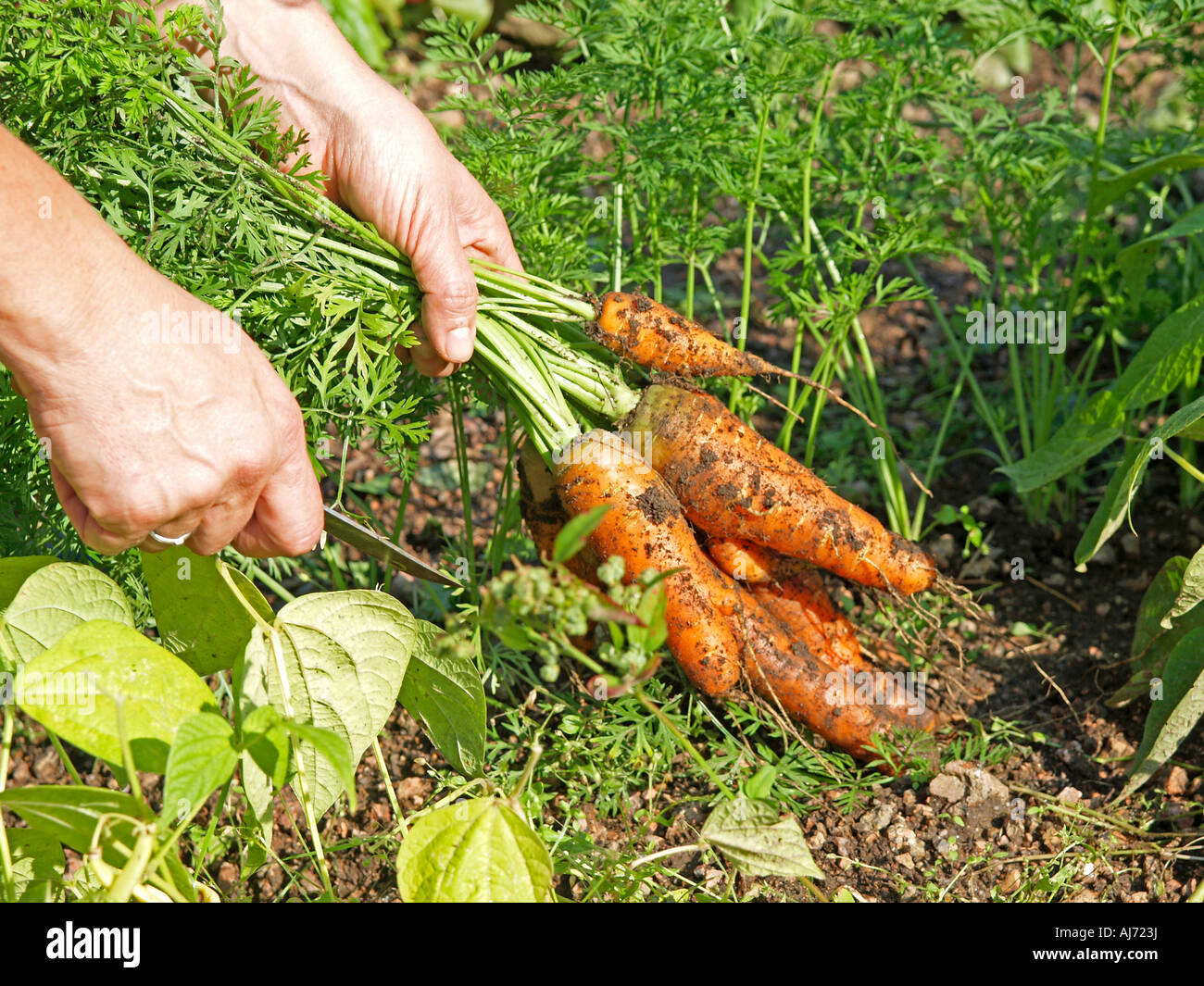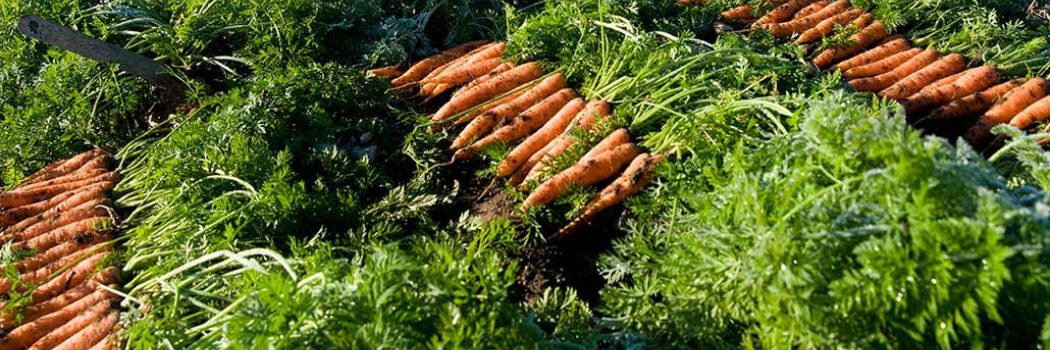Understanding the Growth Stages of Carrots
Carrots (Daucus carota) are biennial root vegetables, but they are often grown as annuals for their edible taproots. The growth stages of carrots are crucial to understanding when to pull carrots for optimal taste, texture, and nutritional value. Carrots grow from seeds and progress through several stages before reaching maturity. These stages include seed germination, cotyledon emergence, vegetative growth, root development, and maturation.
Seed germination is the first step in the carrot growth process, which typically occurs within 10 to 20 days after planting. During this time, the seed absorbs water and swells, causing the embryo to break through the seed coat. The emergence of cotyledons, or the embryonic leaves, follows soon after. These leaves provide the necessary energy for the young seedling to grow.
As the carrot plant continues to grow, it enters the vegetative stage, characterized by the development of true leaves and the establishment of the root system. The taproot begins to thicken and elongate, taking on the familiar orange color and cylindrical shape. The foliage above ground grows rapidly, with the leaves converting sunlight, water, and carbon dioxide into energy through photosynthesis.
The root development stage is the most critical for determining the best time to pull carrots. During this period, the taproot increases in size, accumulating sugars and starches that enhance its flavor and texture. The maturity of the carrot is influenced by factors such as variety, growing conditions, and cultural practices. Understanding the growth stages of carrots is essential for determining the ideal timing for harvesting.
How to Tell When Carrots are Ready for Harvest
Knowing when to pull carrots is essential for achieving the best flavor, texture, and nutritional value. By observing the visual and tactile signs of maturity, gardeners can optimize their harvest for peak freshness and quality. Generally, carrots are ready to harvest approximately 70 to 100 days after planting, depending on the variety. However, the exact timing may vary depending on local growing conditions and cultural practices.
When determining the best time to pull carrots, consider the following factors:
- Size: The size of the carrot is a crucial indicator of maturity. Most varieties reach maturity when they are about 3/4 to 1 inch in diameter at the top of the root. However, some varieties may be thinner or thicker, so it is essential to consult the seed packet or plant tag for specific size recommendations.
- Color: Mature carrots should have a deep, vibrant orange color (for orange varieties), with no traces of green at the top. Green coloration may indicate that the carrot tops have been exposed to sunlight, which can lead to a bitter taste and reduced nutritional value.
- Firmness: A firm, crisp carrot is a sign of optimal maturity. To test for firmness without uprooting the carrot, gently scrape away some soil from the top of the root with your fingers. The carrot should feel solid and unyielding, with no soft or spongy spots.
To harvest carrots, follow these steps:
- Loosen the soil around the carrot with a garden fork or trowel, being careful not to damage the root.
- Gently grasp the carrot top and pull it straight up, applying steady, even pressure.
- If the carrot resists, loosen the soil further and try again. Do not force the carrot out, as this may cause breakage or damage.
- Once the carrot is pulled, remove any excess soil from the root and trim the green tops to about 1/2 inch above the root.
Proper storage is crucial for maintaining carrot quality and longevity. After harvesting, gently wash the carrots and remove any remaining soil. Dry them thoroughly and store them in a cool, dark place with good ventilation. A root cellar or refrigerator crisper drawer are ideal storage locations. By following these guidelines, you can enjoy fresh, delicious carrots for several weeks or even months after harvest.
The Impact of Weather and Season on Carrot Harvesting
Carrot growth and maturity can be significantly influenced by weather conditions and seasonal changes. Understanding the best times of the year to plant and harvest carrots in various climates and regions is essential for optimizing yield and quality. Factors such as temperature, precipitation, and day length can all impact carrot growth and determine when to pull carrots for optimal results.
Carrots generally prefer cooler temperatures, making spring and fall the ideal seasons for planting in most regions. In temperate climates with mild winters, carrots can be grown year-round, while in colder regions, fall planting allows for overwintering and early spring harvest. However, extreme temperatures, either too hot or too cold, can negatively affect carrot growth and development.
- Temperature: Carrots thrive in soil temperatures between 60°F and 75°F (15°C and 24°C). At temperatures below 50°F (10°C), growth slows significantly, while temperatures above 80°F (27°C) can lead to poor root development and bitterness. To ensure optimal growth, monitor soil temperatures and protect carrot plants from extreme temperatures with mulch, row covers, or shade cloth as needed.
- Precipitation: Adequate moisture is essential for carrot growth, but too much water can lead to rot, disease, and reduced yield. Ensure that carrots receive consistent watering, ideally about 1 inch per week, and adjust watering schedules based on local precipitation patterns. Overly dry soil can lead to cracked or misshapen roots, while overly wet soil can result in poor root development and reduced sweetness.
- Day Length: Carrots are day-neutral plants, meaning they will grow and mature regardless of day length. However, shorter days and longer nights can encourage earlier maturity and improved flavor in some varieties. Monitor day length in your region and plan your planting and harvesting schedule accordingly to take advantage of seasonal changes.
In summary, the ideal timing for harvesting carrots depends on various weather and seasonal factors. By understanding the impact of temperature, precipitation, and day length on carrot growth, gardeners can optimize their planting and harvesting schedule for maximum yield and quality. Adjusting cultural practices, such as watering and mulching, to accommodate local weather patterns can further enhance carrot growth and ensure a successful harvest.
Harvesting Techniques for Maximizing Carrot Yield and Quality
Proper harvesting techniques are crucial for maximizing carrot yield, quality, and storage life. When do you pull carrots? The answer depends on the specific growth stage and conditions of your crop. By following best practices, you can minimize root damage, ensure optimal flavor, and maintain freshness for an extended period.
- Loosening the Soil: Before pulling carrots, loosen the soil around the roots to minimize damage and make harvesting easier. Use a garden fork or trowel to gently lift the soil, being careful not to cut or pierce the roots. This process also helps to separate the carrots from any tangled or clustered roots.
- Minimizing Root Damage: To avoid damaging the roots, pull carrots slowly and steadily, applying even pressure. If the carrot resists, loosen the soil further and try again. If necessary, use your hands to gently brush away excess soil from the roots. Damaged roots may affect the carrot’s appearance and storage life, but they are still safe to eat.
- Dealing with Stubborn Carrots: In some cases, carrots may be particularly stubborn or tangled, making harvesting difficult. To address this issue, soak the soil around the carrots with water, which can help to loosen the soil and make pulling easier. Alternatively, use a long-handled fork to carefully lift the carrots from below, being mindful not to pierce the roots. If a carrot breaks during harvest, it can still be used, but it may not store as well as undamaged roots.
- Storing Carrots for Long-Term Use: After harvesting, gently wash the carrots and remove any remaining soil. Dry them thoroughly and store them in a cool, dark place with good ventilation. A root cellar or refrigerator crisper drawer are ideal storage locations. By maintaining proper storage conditions, you can enjoy fresh, delicious carrots for several weeks or even months after harvest.
In summary, harvesting techniques play a significant role in determining the yield, quality, and storage life of carrots. By following best practices, such as loosening the soil, minimizing root damage, and storing carrots properly, you can ensure optimal flavor, appearance, and freshness. When do you pull carrots? By understanding the growth stages and conditions of your crop, you can determine the best time to harvest and enjoy the benefits of freshly harvested carrots.
Common Challenges and Solutions in Carrot Harvesting
Carrot harvesting can present several common issues, including pests, diseases, and poor soil conditions. By understanding these challenges and implementing practical solutions, you can ensure a successful harvest and maintain the health of your carrot crop.
Pests
Carrot pests, such as the carrot rust fly, wireworms, and flea beetles, can damage the foliage and roots of carrot plants. To minimize pest damage, use row covers to protect young plants, practice crop rotation, and remove affected plants promptly. Encourage beneficial insects, such as ladybugs and lacewings, by planting flowers like marigolds, daisies, and sunflowers near your carrot crop.
Diseases
Carrot diseases, such as Alternaria leaf blight, powdery mildew, and root-knot nematodes, can affect the growth and yield of carrot plants. To prevent diseases, maintain good soil drainage, practice crop rotation, and avoid overwatering. Remove affected plants promptly and dispose of them properly to prevent the spread of disease. Consider using disease-resistant carrot varieties, such as ‘Bolero’ or ‘Resistafly,’ to minimize the risk of disease.
Poor Soil Conditions
Carrots prefer loose, well-draining soil with a pH between 6.0 and 6.8. Poor soil conditions, such as heavy clay, rocky soil, or compacted soil, can lead to misshapen or stunted roots. To improve soil conditions, amend the soil with organic matter, such as compost or well-rotted manure, and avoid over-tilling, which can lead to soil compaction. If necessary, consider growing carrots in raised beds or containers to improve soil structure and drainage.
In summary, common challenges in carrot harvesting, such as pests, diseases, and poor soil conditions, can be addressed with practical solutions and preventative measures. By understanding these issues and implementing best practices, you can ensure a successful carrot harvest and maintain the health of your crop. When do you pull carrots? By monitoring the growth stages and conditions of your carrot plants, you can determine the best time to harvest and enjoy the benefits of freshly harvested carrots.
Extending the Carrot Harvest Season: Tips and Tricks
Carrots are a versatile and rewarding crop, and extending the harvest season can provide a steady supply of fresh, delicious carrots for an extended period. By employing strategies such as succession planting, using row covers, and adjusting watering schedules, you can enjoy freshly harvested carrots from early summer to late fall.
Succession Planting
Succession planting is a technique that involves sowing new crops at regular intervals throughout the growing season. By planting carrot seeds every 2-3 weeks, you can ensure a continuous supply of carrots, with mature roots ready for harvest at different times. This method is particularly effective in regions with long growing seasons, as it allows you to take advantage of favorable weather conditions and avoid overcrowding or depleted soil nutrients.
Using Row Covers
Row covers are lightweight, transparent fabrics that can be used to protect young carrot plants from frost, pests, and harsh weather conditions. By covering your carrot beds with row covers, you can create a microclimate that extends the growing season, allowing you to plant and harvest carrots earlier in the spring and later in the fall. Row covers also help to retain soil moisture and warmth, promoting healthy growth and rapid maturation.
Adjusting Watering Schedules
Proper watering is essential for healthy carrot growth and development. By adjusting your watering schedule to accommodate seasonal changes, you can encourage even maturation and extend the harvest season. During periods of high heat or drought, increase watering to maintain soil moisture and prevent premature bolting. Conversely, reduce watering during cooler, wetter periods to prevent root rot and encourage slower, more even growth.
Choosing the Right Varieties
Selecting carrot varieties well-suited for extended harvests is crucial for success. Early-maturing varieties, such as ‘Nantes’ or ‘Danvers 126,’ are ideal for spring and early summer harvests, while late-season varieties, such as ‘Autumn King’ or ‘Touchon,’ can be planted in late summer for fall and winter harvests. Additionally, consider choosing disease-resistant and bolt-resistant varieties to minimize the risk of crop failure and ensure a successful harvest.
In summary, extending the carrot harvest season is an excellent way to enjoy fresh, delicious carrots for an extended period. By employing strategies such as succession planting, using row covers, adjusting watering schedules, and choosing the right varieties, you can ensure a steady supply of freshly harvested carrots. When do you pull carrots? By understanding the growth stages and conditions of your crop, you can determine the best time to harvest and enjoy the benefits of freshly harvested carrots throughout the growing season.
The Benefits of Freshly Harvested Carrots: Taste, Nutrition, and Sustainability
Carrots are a popular and nutritious root vegetable, enjoyed by people around the world for their sweet, crunchy taste and versatile culinary applications. When do you pull carrots? Harvesting carrots at the right time can significantly impact their taste, nutritional value, and overall quality. By understanding the benefits of freshly harvested carrots, you can appreciate the value of homegrown or locally sourced produce and make informed decisions about your carrot harvest.
Improved Taste
Freshly harvested carrots offer a sweeter, more robust flavor compared to store-bought alternatives. As carrots mature, their natural sugars convert to starch, which can result in a less appealing taste. By harvesting carrots at the peak of maturity, you can enjoy their full flavor potential and savor the natural sweetness of this delicious root vegetable.
Higher Nutritional Value
Carrots are rich in essential vitamins and minerals, including beta-carotene, vitamin K, potassium, and dietary fiber. When do you pull carrots? Harvesting carrots at the right time can help to maximize their nutritional value. Freshly harvested carrots contain higher levels of beta-carotene, a powerful antioxidant that can be converted to vitamin A in the body, promoting healthy vision, immune function, and cell growth. Additionally, fresh carrots retain more of their vitamins and minerals compared to carrots that have been stored for an extended period.
Reduced Environmental Impact
Growing and harvesting your carrots can significantly reduce the environmental impact associated with commercial produce. By avoiding the transportation, packaging, and storage requirements of store-bought carrots, you can contribute to a more sustainable food system and enjoy the satisfaction of producing your own nutritious, delicious vegetables. Furthermore, homegrown carrots can be grown without the use of synthetic fertilizers, pesticides, or other chemicals, promoting a healthier environment and a safer food supply.
In summary, freshly harvested carrots offer numerous benefits, including improved taste, higher nutritional value, and reduced environmental impact. By understanding the advantages of homegrown or locally sourced produce, you can make informed decisions about your carrot harvest and enjoy the full flavor and nutritional potential of this versatile root vegetable. When do you pull carrots? By monitoring the growth stages and conditions of your crop, you can determine the best time to harvest and enjoy the benefits of freshly harvested carrots.







